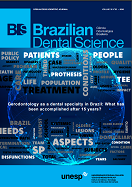Incidental findings of bone alterations in temporomandibular joints in cone-beam computed tomography scans adquired for implants planning: the importance of complete field of view analysis
DOI:
https://doi.org/10.14295/bds.2016.v19i2.1243Resumo
Objective: to evaluate the frequency of bone alterations in temporomandibular joints (TMJ) in of cone beam computed tomography (CBCT) images, with dental implats planning purpose. Material and Methods: 148 cone beam exames were selected from the file of the Radiology Clinic ICT UNESP. All the images were performed by Next Generation i-CAT (Imaging Sciences Ltda, Hatfield, PA, USA) scanner, using voxel of 0.20/0.25 mm and FOV of 16.0 x 13.0 cm for dental implants planning. All the images should show both (rigth and left) TMJ condyle. The TMJ condyle were reformated using TMJ protocol, with parassagital slices, perpendicular to the long axis of TMJ condyle, in order to study presence of the following bone alterations: osteophytes, erosion, flatenning, bone sclerosis and cortical thinning. Results: The results showed that 63.51% of the sample belonged to female and 36.49% to male. In addition, it was noted that the most frequent bone alterations in condyle were osteophytes (56.75%) and flatening (55.4%). The erosion was the alteration with lower frequency (0,67%). The statistic test of Mcnemar showed that there was relationship between flatening and erosion, flatening and bone sclerosis, flatening and cortical thinning, erosion and osteophytes, bone sclerosis and cortical thinning (p<0.0001), in both sides. There was no relationship between flatening and osteophytes, erosion and bone sclerosis, erosion and cortical thinning (p>0.01). Conclusion: the hight frequency of bone alterations findings in TMJ condyle was an indicator of the importance of the analysis of all the structures present in the CBCT FOV, regardless its indication.
Downloads
Downloads
Arquivos adicionais
Publicado
Como Citar
Edição
Seção
Licença
TRANSFERÊNCIA DE DIREITOS AUTORAIS E DECLARAÇÃO DE RESPONSABILIDADE
Toda a propriedade de direitos autorais do artigo "____________________________________________________________________" é transferido do autor(es) para a CIÊNCIA ODONTOLÓGICA BRASILEIRA, no caso do trabalho ser publicado. O artigo não foi publicado em outro lugar e não foi submetido simultaneamente para publicação em outra revista.
Vimos por meio deste, atestar que trabalho é original e não apresenta dados manipulados, fraude ou plágio. Fizemos contribuição científica significativa para o estudo e estamos cientes dos dados apresentados e de acordo com a versão final do artigo. Assumimos total responsabilidade pelos aspectos éticos do estudo.
Este texto deve ser impresso e assinado por todos os autores. A versão digitalizada deverá ser apresentada como arquivo suplementar durante o processo de submissão.




























